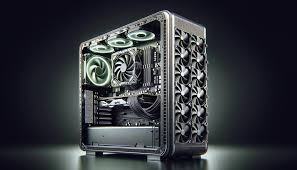Gaming has transformed into a thrilling adventure, where every frame matters and performance can make or break the experience. If you’ve ever experienced lag during an intense boss fight or noticed your graphics stuttering in a beautifully rendered open-world game, you know how frustrating it can be. At the heart of these issues often lies a struggle between two key players: the CPU and GPU.
In this tech-savvy realm, enthusiasts—many of whom gather at events like Geeks Callout in London—constantly seek ways to enhance their machines for peak performance. Understanding how to balance CPU and GPU efficiency is essential for gamers wanting to squeeze out every drop of potential from their setups. Let’s dive deep into unlocking that elusive gaming nirvana by overcoming bottlenecks together!
Understanding CPU and GPU Performance
The CPU, or central processing unit, acts as the brain of your gaming PC. It handles calculations and processes data at lightning speed. Its performance is crucial for tasks like game physics and AI behaviour.
On the other hand, we have the GPU or graphics processing unit. This powerhouse is responsible for rendering images, textures, and animations. Gamers often prioritize a high-quality GPU to enjoy rich visuals without sacrificing frame rates.
Both components work in tandem but excel at different functions. When optimized correctly, they significantly enhance each other’s capabilities. A bottleneck occurs when one component outpaces the other, leading to underwhelming performance overall.
Understanding these differences can help prevent frustrating gameplay experiences. Recognizing how balancing their strengths impacts everything from loading times to graphical fidelity in your favourite games is essential.
Identifying Bottlenecks in Gaming PCs
Bottlenecks in gaming PCs are frustrating and can drastically impact your experience. They occur when one component, often the CPU or GPU, limits the performance of others.
To identify these bottlenecks, start by monitoring system metrics during gameplay. Tools like MSI Afterburner or HWMonitor provide real-time insights into resource usage. If you notice 100% utilization on your CPU while your GPU is underused, the CPU is likely holding back potential performance.
Another method involves benchmarking different games to see where frame rates dip significantly. Some games may be more demanding on the CPU or GPU, revealing which component struggles under pressure.
Keep an eye out for stuttering or lagging during high-action sequences; this could indicate a weak point in your setup. Understanding these signs helps tailor upgrades effectively and enhances overall gaming enjoyment.
Importance of Balancing CPU and GPU Performance
Balancing CPU and GPU performance is crucial for an optimal gaming experience. When these components work harmoniously, gamers can enjoy smooth gameplay without hiccups.
A powerful GPU might seem like the ultimate upgrade, but if it’s paired with a weaker CPU, you may not see significant improvements. The CPU handles game logic, physics calculations, and AI processes. If it’s overwhelmed, your fancy graphics card can’t do its job effectively.
On the other hand, an underperforming GPU can limit visual quality and frame rates regardless of how fast your CPU runs. Gamers deserve stunning visuals and top-notch performance simultaneously.
Finding that sweet spot ensures you’re utilizing both components efficiently. This balance leads to higher frame rates and better game responsiveness—essential factors for competitive play or immersive storytelling experiences. It ultimately enhances enjoyment and satisfaction while gaming at any level.
How to Balance CPU and GPU for Optimal Gaming Performance
To achieve optimal gaming performance, assess your current CPU and GPU specifications. Knowing their capabilities will help you identify areas for improvement.
Upgrade either component based on the games you play most often. Consider investing in a more powerful GPU if you’re into graphics-intensive titles. For CPU-heavy games, an upgrade to a faster processor could be beneficial.
Adjusting game settings is also crucial. Lowering graphical fidelity can relieve pressure from the GPU while ensuring that the CPU remains active in rendering complex tasks.
Utilizing tools like MSI Afterburner or NVIDIA’s GeForce Experience allows real-time monitoring of both components during gameplay. This data helps pinpoint any performance lags and informs future tweaks.
Keep your system clean from dust and ensure proper cooling solutions are in place to prevent thermal throttling—this ensures both parts operate at peak performance without overheating issues.
The Role of Overclocking in Balancing Performance
Overclocking can be a game-changer for gamers looking to squeeze every performance drop from their hardware. By pushing the CPU or GPU beyond its factory settings, you can achieve higher frame rates and smoother gameplay.
However, this process isn’t without risks. Increased heat generation necessitates efficient cooling solutions. Without adequate cooling, components may throttle or even suffer permanent damage.
It’s crucial to find that sweet spot. Too much overclocking on either end might lead to instability, causing choppy experiences instead of enhancing them.
Monitoring tools play an essential role here. They help track temperatures and performance metrics in real time, allowing for adjustments as needed.
While overclocking presents advantages, it’s essential not to neglect balance with other system components. The ultimate goal is harmonious synergy between your CPU and GPU for the best gaming experience possible.
Common Mistakes to Avoid
Many gamers unknowingly fall into traps that hinder their performance. One common mistake is neglecting to monitor CPU and GPU usage during gameplay. This oversight can obscure potential bottlenecks and lead to suboptimal settings.
Another frequent error involves over-reliance on a single component. Focusing solely on upgrading the GPU while ignoring the CPU can create an imbalance, resulting in wasted resources.
Additionally, misunderstanding resolution settings often leads to problems. Playing at ultra-high resolutions without sufficient hardware can strain both components unevenly.
Overlooking thermal management is a critical misstep. Poor cooling solutions may cause throttling, affecting overall performance drastically.
By recognizing these pitfalls, gamers can take proactive measures for smoother experiences and improved frame rates.
Conclusion: Achieving the Perfect Balance for an Enhanced Gaming Experience
Striking the right balance between CPU and GPU performance is essential for gaming enthusiasts. A well-optimized system ensures that both components work harmoniously, delivering a seamless experience without frustrating bottlenecks.
Understanding how these parts interact, identifying where issues may arise, and employing techniques to fine-tune your setup can elevate your gaming sessions to new heights. Consider overclocking carefully and avoid common pitfalls that could hinder your progress.
Achieving this equilibrium isn’t just about raw power; it’s about creating an environment where every game runs smoothly and looks stunning. With a bit of knowledge and effort, you can transform your gaming PC into a powerhouse tailored precisely to your needs. Embrace the journey toward optimization—your future gaming experiences will thank you!

